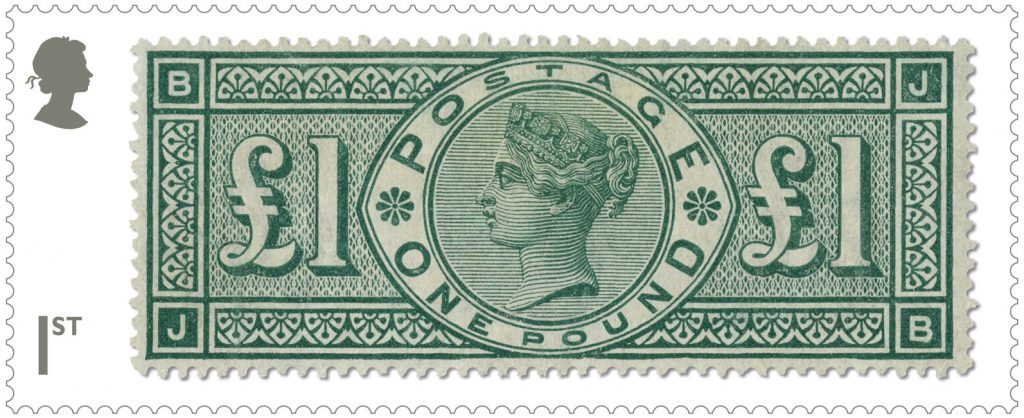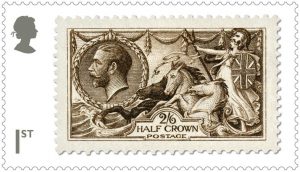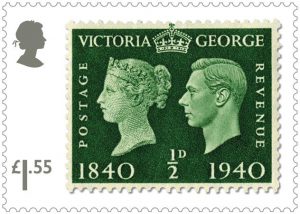Royal Mail announced its first 2019 “Special Stamp” issue, a six-piece set dubbed “Stamp Classics,” last week.
Each of the stamps is a key and admired design from each monarch’s reign – from Queen Victoria to Queen Elizabeth II – since Rowland Hill initiated the first postage stamp, the Penny Black, in 1840.
The stamps featured in the set are:
- the Queen Victoria £1 green of 1891;
- the King Edward VII two-pence Tyrian plum of 1910;
- the King George V two-shilling, six-pence stamp of 1913;
- the King Edward VIII one-and-a-half-shilling stamp of 1936;
- the King George VI “Penny Black Centenary” half-pence stamp of 1940; and
- the Queen Elizabeth II coronation two-and-a-half-pence stamp of 1953.
The six stamps are printed within a miniature sheet.
1891 £1 VICTORIA
The Queen Victoria £1 value was changed to green on Jan. 28, 1891, after the original design was issued in brown lilac in 1884.
The horizontal design replaced an earlier £1 released in 1878.
The ornate style is typical of the stamps of the reign, created to prevent forgery. The corner letters, changing from stamp to stamp in the sheet, served the same purpose.
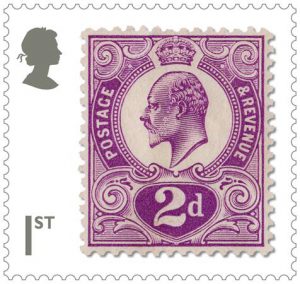
The iconic 1910 Tyrian plum, one of the great rarities of British philately, is also featured in the six-stamp set.
1910 TYRIAN PLUM
A move from two-colour stamps, which were introduced to reduce costs, saw the King Edward VII two-pence stamp re-designed.
In April 1910, the denomination was printed in Tyrian plum; however, post offices still held stocks of the former design, so the new stamp was not released.
On the death of the king, the postmaster general decided not to issue the stamp. Only one is known to have been used, this on an envelope addressed to the Prince of Wales: it arrived on May 6, 1910, the day he became King George V.
1913 ‘SEAHORSE’
The high values of King George V, known as the “Seahorses,” are widely regarded as classic stamps of the world.
The design was by Bertram Mackennal with lettering by George Eve.
The two-shilling, six-pence stamp, as well as the five-shilling denomination, were issued June 30, 1913. The 10-shilling stamp and £1 denomination were issued soon after, on Aug. 1, 1913.
Four different printers produced the stamps, and the work of each is identifiable.
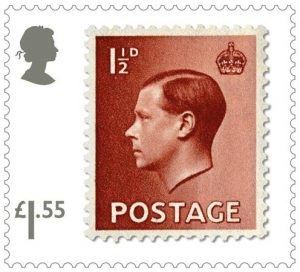
The 1936 King Edward VIII one-and-a-half-shilling stamp is also in the Royal Mail’s ‘Stamp Classics’ set.
1936 EDWARD VIII
Ambitious plans were made for accession, coronation and permanent issues for King Edward VIII, although only four values of the accession set were issued.
These included the half-pence, one-and-a-half-pence and two-and-a-half-pence denominations on Sept. 1, 1936, and the one-pence denomination on Sept. 14.
In April 1936, 17-year-old student Hubert Brown submitted a speculative design to the postmaster general, and this became the basis of the issued stamp.
1940 PENNY BLACK CENTENARY
The post office planned to celebrate the centenary of the Penny Black, for which designs were invited; however, following the outbreak of war, the issue was abandoned until December 1939, when the postmaster general felt the decision was premature.
The King, in consultation with the Queen, favoured a design by Harold Palmer. It was issued on May 6, 1940, in six values and an unusual size for British stamps.
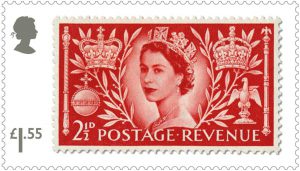
Lastly, the 1953 Queen Elizabeth II coronation two-and-a-half-pence stamp rounds out the six-piece set.
1953 QEII CORONATION
To celebrate the Coronation of Queen Elizabeth II on 2 June 1953, four stamps were issued on the following day. As always in those days, many designers were invited to compete and over 75 ideas were submitted. Four were chosen, each from a different artist: Edgar Fuller (2½d), Michael Goaman (4d), Edmund Dulac (1s 3d) and Michael Farrar-Bell (1s 6d). Consequently, the result is a mixture of styles.
RPSL’S 150th ANNIVERSARY
This stamp issue is a celebration of the Royal Mail’s stamp history as well as philately in general, marking the 150th anniversary of the Royal Philatelic Society London (RPSL) and the 50th anniversary of the Queen opening the National Postal Museum, now known as the Postal Museum.
Founded on April 10, 1869, the RPSL is the oldest philatelic society in the world. It was granted permission to use the “Royal” prefix in November 1906 by King Edward VII. The future King George V became its president in 1896, and on his accession, he became the society’s patron.
The society promotes the study of philately through regular meetings, exhibitions, scholarships, publishing books, its world-renowned library, philatelic collections, the Museum of Philatelic History and a journal, The London Philatelist.
The society’s patron is Queen Elizabeth II.
“The Royal Philatelic Society London welcomes the excellent Royal Mail ‘Stamp Classics’ released early in the Society’s 150th Anniversary celebrations,” said RPSL President-Elect Richard Stock.
“The stamps featured are truly representative of those issued during each reign.”

